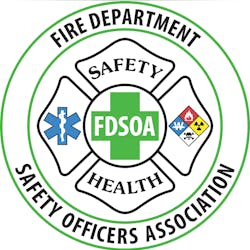SCOTTSDALE, Ariz. – The type and size of apparatus in communities can affect insurance ratings, so departments should be thoughtful when selecting new firefighting vehicles.
A full 50 percent of the score to determine the Insurance Service Office (ISO) rating is attributed to apparatus, Skip Gibson, Community Hazard Mitigation manager for ISO, told dozens of firefighters during his presentation at the Fire Department Safety Officers Association annual Apparatus Symposium.
“Departments must have at least a 750 gpm pump, haul 4,000 gallons on a first alarm and pump at least 250 gpm for 20 minutes to get a [class] rating of eight,” Gibson said. “Most of them are doing it, but they don’t ask for the certification or credit for it.”
Gibson explained there’s a huge benefit from going from a Class 9 to a Class 8 or better as insurance customers can realize a savings of a third to two thirds.
“It’s a big jump to go from a nine to an eight,” Gibson said, explaining that ISO, a grandchild of the National Board of Fire Underwriters, is used to help insurance companies price insurance policies.
He explained that ISO spends more time evaluating and auditing fire departments than physically testing them as they once did.
Gibson said the ISO rating is based on a 100-point evaluation with emergency communications worth 10 percent, fire operations at 50 percent and water supply 40 percent. Additionally, community risk reduction efforts can add 5.5 percentage points to the score.
ISO looks at fire department locations and water sources too, Gibson said. Property more than five miles from a fire station can have a rating of 10, but if it has water within 1,000 feet, it can incrementally increase the score.
He also said it’s not uncommon for departments to lose ground, points and class ratings on new revaluations because circumstances change.
“There’s a thing as divergence balances,” Gibson said. “You can have lots of water, but no fire department and you can have no water, but a great department.”
Fire flows need to be considered when determining the ISO score, he said, noting that there are minimum criterion for each section and the evaluation is performance based. Training records are reviewed during an ISO evaluation so the agency knows who is responding and from where and when.
Gibson said ISO has done away with some of the antiquated requirements for things like hose jackets.
“Now we look at whatever NFPA 1901 says that is needed, that’s good enough for us,” Gibson said. He added that many fire chiefs are concerned their departments will never be fully NFPA compliant.
“You don’t need to be fully NFPA compliant,” Gibson said. That’s a high benchmark. We’ll give you credit for what you have.”
Gibson said most communities need a fire flow of 3,500 gpm and to achieve that, communities will need three engines, or a combination of an engine, a quint and an aerial with the sum total to meet the pumping requirement.
He offered some tips to help department get the most points during an evaluation.
“Make sure you have annual pump tests,” Gibson said, noting that annual testing will earn 100 percent of that portion of the scoring. Falling to test every three years will cut the score in half and for five or more years, no points will be awarded.
Aerials need to be tested and certified to get full credit in that line as well, he said.
Answering a question from the audience, Gibson said ISO offers no points or extra credits for apparatus equipped with compressed air foam systems (CAFS). That’s largely based on the fact that NFPA doesn’t have any standard for CAFS. Scoring criterion is reviewed every four to five years and perhaps the next round will include some consideration for CAFS.
Gibson said ISO wants to help fire departments get the best rating they can and departments need to reach out and get information as needed.
”Make sure you ask questions,” Gibson said. “It’s important to your community.”
More from FDSOA:
- FDSOA's Apparatus Symposium Opens in Ariz.
- FDSOA Symposium: Diesel Emissions Standards Need not be so Scary
- FDSOA Symposium: NFPA 2015 Apparatus Standards Reviewed
- FDSOA Symposium: Politics Play a Role in Apparatus Purchasing
- FDSOA Symposium: Experts Field Apparatus Questions
- FDSOA Symposium: Detroit FD Weathers City's Bankruptcy
- FDSOA Symposium: Apparatus Design Is Important for ISO Ratings
- FDSOA Symposium: Drones Can Be Valuable Tools For Responders
- FDSOA Symposium: NFPA Focused on Alternative Fuel Emergency Safety
- FDSOA Symposium: Graham Lectures on True Risk Managment
- FDSOA Symposium: Pros and Cons of Thermal Imagers Discussed
- FDSOA Symposium: Maintenance is Key to Keeping Apparatus on the Road






